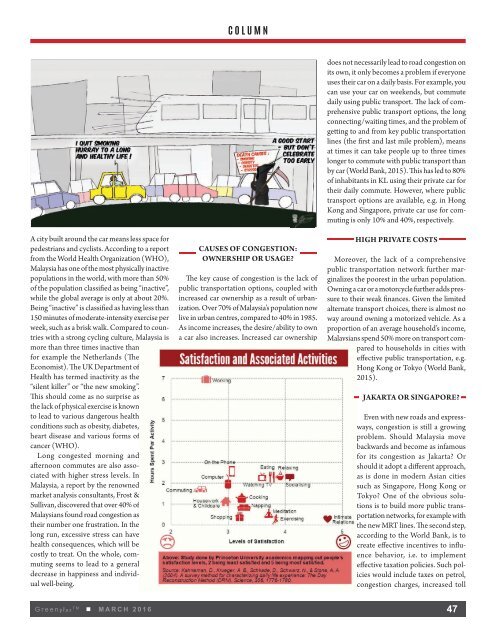Green Plus Issu 14
You also want an ePaper? Increase the reach of your titles
YUMPU automatically turns print PDFs into web optimized ePapers that Google loves.
COLUMN<br />
A city built around the car means less space for<br />
pedestrians and cyclists. According to a report<br />
from the World Health Organization (WHO),<br />
Malaysia has one of the most physically inactive<br />
populations in the world, with more than 50%<br />
of the population classified as being “inactive”,<br />
while the global average is only at about 20%.<br />
Being “inactive” is classified as having less than<br />
150 minutes of moderate-intensity exercise per<br />
week, such as a brisk walk. Compared to countries<br />
with a strong cycling culture, Malaysia is<br />
more than three times inactive than<br />
for example the Netherlands (The<br />
Economist). The UK Department of<br />
Health has termed inactivity as the<br />
“silent killer” or “the new smoking”.<br />
This should come as no surprise as<br />
the lack of physical exercise is known<br />
to lead to various dangerous health<br />
conditions such as obesity, diabetes,<br />
heart disease and various forms of<br />
cancer (WHO).<br />
Long congested morning and<br />
afternoon commutes are also associated<br />
with higher stress levels. In<br />
Malaysia, a report by the renowned<br />
market analysis consultants, Frost &<br />
Sullivan, discovered that over 40% of<br />
Malaysians found road congestion as<br />
their number one frustration. In the<br />
long run, excessive stress can have<br />
health consequences, which will be<br />
costly to treat. On the whole, commuting<br />
seems to lead to a general<br />
decrease in happiness and individual<br />
well-being.<br />
CAUSES OF CONGESTION:<br />
OWNERSHIP OR USAGE?<br />
The key cause of congestion is the lack of<br />
public transportation options, coupled with<br />
increased car ownership as a result of urbanization.<br />
Over 70% of Malaysia’s population now<br />
live in urban centres, compared to 40% in 1985.<br />
As income increases, the desire/ability to own<br />
a car also increases. Increased car ownership<br />
does not necessarily lead to road congestion on<br />
its own, it only becomes a problem if everyone<br />
uses their car on a daily basis. For example, you<br />
can use your car on weekends, but commute<br />
daily using public transport. The lack of comprehensive<br />
public transport options, the long<br />
connecting/waiting times, and the problem of<br />
getting to and from key public transportation<br />
lines (the first and last mile problem), means<br />
at times it can take people up to three times<br />
longer to commute with public transport than<br />
by car (World Bank, 2015). This has led to 80%<br />
of inhabitants in KL using their private car for<br />
their daily commute. However, where public<br />
transport options are available, e.g. in Hong<br />
Kong and Singapore, private car use for commuting<br />
is only 10% and 40%, respectively.<br />
HIGH PRIVATE COSTS<br />
Moreover, the lack of a comprehensive<br />
public transportation network further marginalizes<br />
the poorest in the urban population.<br />
Owning a car or a motorcycle further adds pressure<br />
to their weak finances. Given the limited<br />
alternate transport choices, there is almost no<br />
way around owning a motorized vehicle. As a<br />
proportion of an average household’s income,<br />
Malaysians spend 50% more on transport compared<br />
to households in cities with<br />
effective public transportation, e.g.<br />
Hong Kong or Tokyo (World Bank,<br />
2015).<br />
JAKARTA OR SINGAPORE?<br />
Even with new roads and expressways,<br />
congestion is still a growing<br />
problem. Should Malaysia move<br />
backwards and become as infamous<br />
for its congestion as Jakarta? Or<br />
should it adopt a different approach,<br />
as is done in modern Asian cities<br />
such as Singapore, Hong Kong or<br />
Tokyo? One of the obvious solutions<br />
is to build more public transportation<br />
networks, for example with<br />
the new MRT lines. The second step,<br />
according to the World Bank, is to<br />
create effective incentives to influence<br />
behavior, i.e. to implement<br />
effective taxation policies. Such policies<br />
would include taxes on petrol,<br />
congestion charges, increased toll<br />
<strong>Green</strong>plus TM MARCH 2016<br />
47


